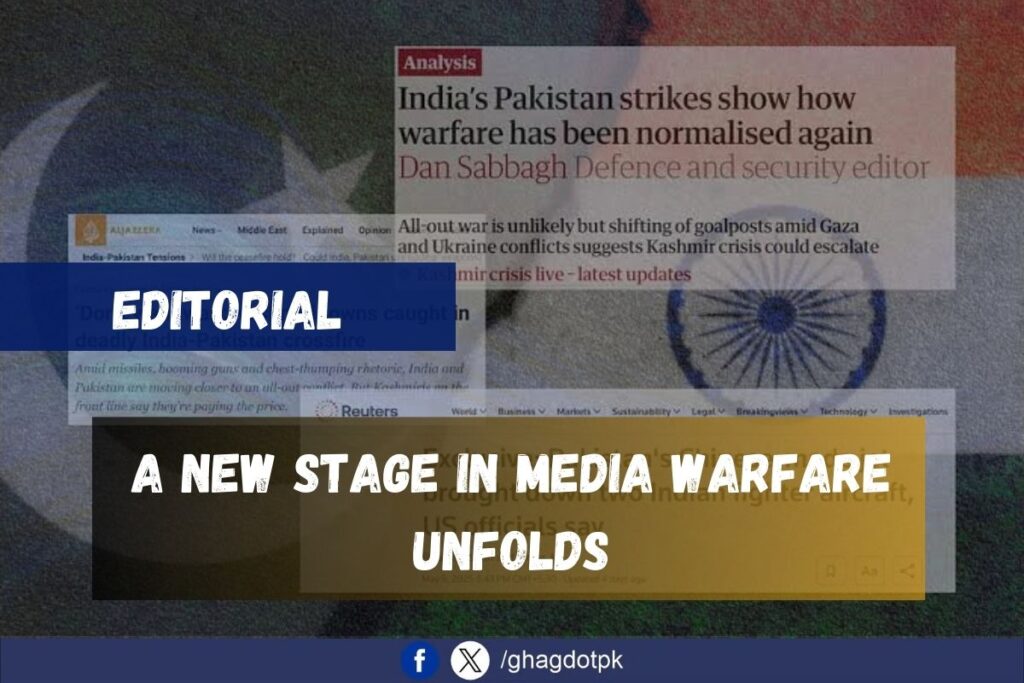As expected, India has once again orchestrated a war hysteria under systematic state patronage. However, this time the campaign’s scope has expanded beyond Pakistan, now encompassing the United States, Türkiye, Azerbaijan, Iran, China, and Afghanistan. It would not be inaccurate to say that India has effectively categorised all these countries as adversaries. Meanwhile, Pakistan’s diplomatic engagements and global relevance continue to grow steadily. Foreign Minister Ishaq Dar, along with his delegation, has arrived in Beijing for a three-day official visit. During the trip, he is scheduled to hold consultations with senior Chinese officials on the evolving regional landscape, and both Pakistani and Chinese foreign ministers will also meet with Afghanistan’s Foreign Minister, Amir Khan Muttaqi.
In India, efforts are being made to create the impression that another strike on Pakistan is imminent, and that the previous ceasefire decision was not made at the behest of former US President Donald Trump. When India’s Foreign Secretary made this claim publicly yesterday, it caused widespread astonishment, even prompting questions from within the US itself. Political and media circles are now actively discussing how not only China and Türkiye, but also the US, Iran, Azerbaijan, the UAE, Saudi Arabia, and Qatar appear to be distancing themselves from India and siding with Pakistan. Through this narrative, the Indian government aims to quell public dissent by portraying itself as courageously confronting a multitude of powerful nations alone. Simultaneously, it is promoting the propaganda that Afghanistan’s interim rulers, along with groups such as the TTP and BLA, are Indian allies and will collaborate to destabilise Pakistan through proxy warfare.
On one hand, the visit of a deputy minister from the Afghan interim government to New Delhi has been exaggerated; on the other, undue importance is being given to a recent article written by former TTP spokesperson Ehsanullah Ehsan, published in the Indian newspaper Sunday Guardian. In the article, he alleged that major attacks will soon take place in a key Indian city and along the India-China border. He also accused Pakistan’s military establishment of involvement in the Pahalgam attack. Pakistani authorities have countered these claims, asserting that Ehsan is acting under the instructions of Indian intelligence agencies. Nevertheless, Indian media outlets and anti-state elements continue to aggressively exploit these accusations and so-called revelations.
Political and civil society circles in Pakistan have strongly reacted to reports of children martyred in an alleged drone strike in South Waziristan. One narrative suggests the children were killed in a Pakistani military drone attack, while security sources maintain the operation was carried out by banned militant groups in an attempt to reignite tensions between the state and the public. Security officials claim that the banned TTP has acquired advanced quadcopter drones, sightings of which have been reported in several other tribal areas, leading to suspicions that this attack was also executed using similar technology by the TTP.
Experts are warning that a resurgence in attacks and activities by banned outfits is likely in the coming days, a concern shared by security agencies. In this context, while the banned TTP claimed responsibility for a suicide attack on a security forces’ fort in Chaman, Balochistan—alleging significant casualties—the security forces issued a statement outlining recent operations in North Waziristan, Bannu, and Lakki Marwat. According to the statement, nine TTP militants were neutralised during these operations. The ISPR also confirmed that two security personnel were martyred during the engagements.
Only time will reveal the full extent of Pakistan’s future security landscape. However, it is becoming increasingly clear that, in addition to internal security challenges, the country will also face a new wave of media warfare on multiple fronts. There appears to be a coordinated effort to strategically encircle Pakistan through both physical and informational battlegrounds.






